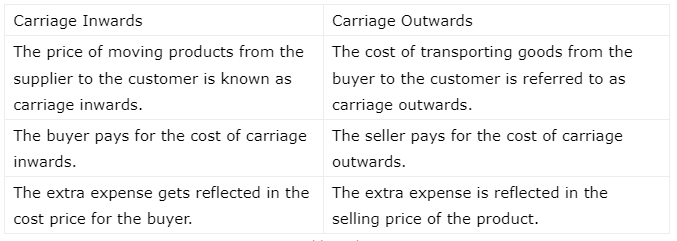Economics terms like “carriage inwards” and “carriage outwards” are used to talk about the expenses associated with transporting products. These ideas are critical in calculating the final cost of items as well as a business’s pricing strategy. It is also crucial for businesses in terms of accounting and taxation.
Definition of Carriage Inwards:
The price of moving products from the supplier to the customer is known as carriage inwards. Freight costs, customs duties, taxes, and other expenses can all be included in this price. The buyer bears these expenses, which are often transferred to the client in the form of higher prices. The cost of carriage inwards can have a considerable impact on the final cost of goods, and firms must be aware of this.
Definition of Carriage Outwards:
The cost of transporting goods from the buyer to the customer is referred to as carriage outwards. This cost may include freight, handling fees, and other charges. These expenses are borne by the seller and are usually reflected in the selling price of the goods.
Example:
Consider the following scenario. Suppose that you run a business and are buying goods from two different manufacturers, say Manufacturer A and Manufacturer B.
Manufacturer A is willing to sell the goods for a cost of 50 dollars per unit whereas Manufacturer B is willing to sell the goods for a cost of 46 dollars per unit. One cannot immediately conclude that buying from manufacturer B is more profitable since we have not considered the carriage costs. For example, if Manufacturer A is willing to transport the goods for free and Manufacturer B charges 5 dollars per unit as the cost of transportation then it immediately becomes clear to us that buying from Manufacturer A is more profitable.
This is because the total cost (including delivery cost) per unit is 50 dollars for Manufacturer A whereas it is 51 dollars for Manufacturer B. Thus it is cheaper and hence more profitable to buy the goods from Manufacturer A.
Factors on which carriage costs depend:
In general, the cost of carriage inwards and outwards varies according to the mode of transportation used, the distance the goods must be transported, and the type of goods being transported. For example, if a manufacturer needs to transport raw materials from a supplier in another country rather than a supplier in the same country, the cost of carriage inwards may be higher. Similarly, if a retailer needs to transport goods to customers in remote areas rather than customers in urban areas, the cost of carriage outwards may be higher.
Businesses may control the expenses of transportation both internally and externally by putting good logistics and supply chain management practices into place. Businesses can, for instance, use alternative modes of transportation to reduce the cost of carriage and negotiate better terms and rates with suppliers and carriers. Additionally, companies can automate and improve their supply chain and logistics processes using technology like transportation management systems (TMS).
Difference between Carriage Inwards and Carriage Outwards:
The main differences between carriage inwards and carriage outwards are summarized in the table below.
| Carriage Inwards | Carriage Outwards |
| The price of moving products from the supplier to the customer is known as carriage inwards. | The cost of transporting goods from the buyer to the customer is referred to as carriage outwards. |
| The buyer pays for the cost of carriage inwards. | The seller pays for the cost of carriage outwards. |
| The extra expense gets reflected in the cost price for the buyer. | The extra expense is reflected in the selling price of the product. |
